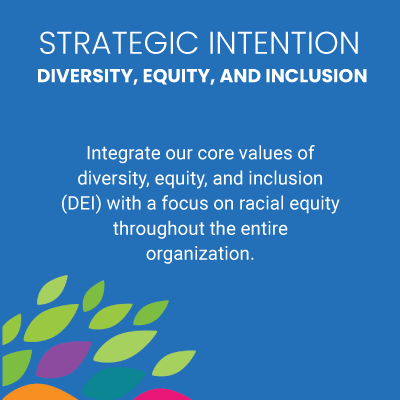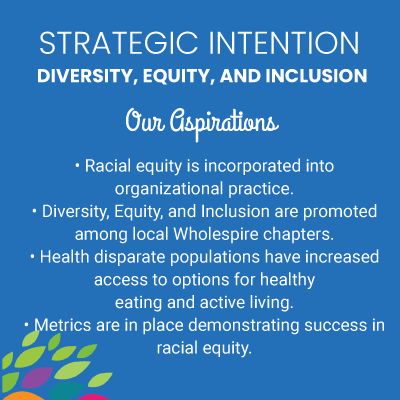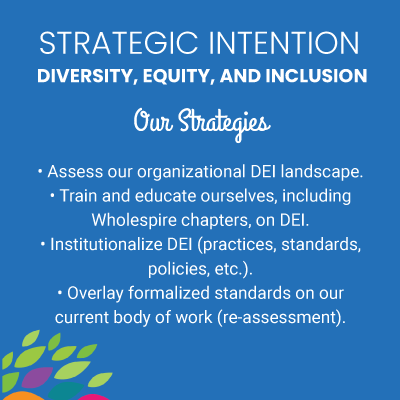Honest conversations about race equity are challenging leaders, especially nonprofit leaders, to dig deeper. One of the ways that Wholespire is digging deeper is by asking: What internal work also needs to be done? How do we become a more equitable workplace that’s living out our mission? At Wholespire, we developed a strategic intention related to DEI, but we are closely focusing on race equity within that intention. In this post, I will explain Wholespire’s path to making diversity, equity, and inclusion, specifically race equity, a priority within our workplace.
What are Diversity, Equity, Inclusion (DEI) and Race Equity and Inclusion (REI)?

Let’s start with some definitions. Diversity, equity, and inclusion (DEI) is often defined based on its three components (DEI Extension).
- Diversity is the presence of differences that may include race, gender, religion, sexual orientation, ethnicity, nationality, socioeconomic status, language, (dis)ability, age, religious commitment, or political perspective.
- Equity is promoting justice, impartiality, and fairness within the procedures, processes, and distribution of resources by institutions or systems.
- Inclusion is an outcome to ensure those that are diverse actually feel and/or are welcome.
Race equity is the process of eliminating racial disparities and improving outcomes for everyone. It is the intentional and continual practice of changing policies, practices, systems, and structures by prioritizing measurable change in the lives of people of color (Race Forward).
Why Lead with Race Equity?
In 2020, while Wholespire was drafting the 2021-2023 strategic plan, racism and social justice were catching the attention of mainstream news outlets and the world. This was mostly due to the deaths of Breonna Taylor, Ahmaud Arbery, and George Floyd and the health disparities that became more visible as a result of COVID-19. As a part of commitment to racial justice, our staff and board felt strongly that our core value of equity should be included in our strategic plan. While equity was already an underlying component of our work, giving it its own strategic focus made it more intentional. Focusing on race equity meant that we would identify and track specific actions.
HealthEquityGuide.org lays out three reasons why equity work should be led by race:

- Racial inequities persist in every system across the country, without exception.
- Racial inequities are found within other dimensions of identity — income, gender, sexuality, education, ability, age, citizenship, and geography.
- Inflaming racial tension has been a deliberate political strategy by those seeking to maintain their own power.
Wholespire’s Steps to Advancing Race Equity
Equity is not a new value for Wholespire, but we saw the need to be more intentional with incorporating equitable practices and procedures into how we operate as a workplace. We created a timeline of the steps taken toward advancing race equity in our workplace. It has taken some time to achieve what we have so far, but we’ve been intentional about it. Below are some steps you can take to advance race equity in your workplace:
- Develop A Common Understanding. Professional development and personal growth are essential for staff, board members, and partners to truly understand why DEI and race equity are important.
- Put it on Paper. Document, document, document. Include DEI and race equity in your strategic plan or policies.
- Complete an Assessment. Review your current DEI and race equity practices to identify areas that need work.
- Set Goals. Use your assessment results to create measurable goals for growth.
- Track Progress. Monitor your work regularly and make adjustments where needed.
- Reflect. At the end of your reporting period, evaluate your work toward meeting your goals.
Resources

There are countless resources and tools available to individuals and organizations who are interested in advancing race equity. One of the challenging things is reviewing those resources and tools to determine what is best for your organization. Below are some of the trainings, assessments, and resources that Wholespire has used in our race equity work.
- Leadership Guide for Promoting Race Equity and Inclusion in the Workplace
- Practitioner’s Guide for Promoting Race Equity and Inclusion in the Workplace
- REI Assessment
- The Welcome Table SC
- PEACE Training Series (Zenger Strategies)
- Equity Literacy Institute
When I participated in a race equity facilitator’s training led by the Equity Literacy Institute, I learned that race equity work should be about eliminating racism. We were given tools to shift our thinking about racism.
One shift is from viewing racism as an occasional incident that needs to be addressed when witnessed or reported to viewing racism as ordinary and affecting everything and requiring ongoing proactive action. This is, in my opinion, the most important lesson from this blog.
Every organization or coalition has a starting point and should be tackling race equity on a regular basis. Here are some questions to think about:
- Where does racism exist in the way my organization conducts business?
- What is my organization doing to combat racism in the workplace on a regular basis?
- How does my company ensure that Black employees feel safe and welcome?
- Are our DEI and race equity efforts reducing racism in the workplace?
Wholespire’s race equity efforts are not temporary. We will continue to evolve and provide a more inclusive environment for all staff and board members. We recognize that we will not always “get it right,” and that we will make mistakes, but we strive to be a workplace where everyone feels secure, respected, and valued. We hope that our goals, activities, outcomes, and support motivate our chapters, partners, and stakeholders to follow suit.
My next blog will focus on the six steps outlined above. If you want to learn more about Wholespire’s race equity in the workplace journey, visit our DEI webpage. It has complete information about our framework, as well as resources to explore. You can also find race equity resources on Options for Action.

